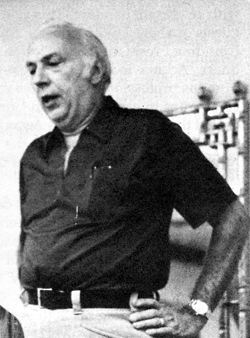By Dr. Sol Taylor
"Making Cents"
Saturday, April 12, 2008
|
| M |
At the American Numismatic Association show in San Francisco in the summer of 2005, the convention floor fell silent for a moment of respect when it was announced that John J. Ford had died. Ford was a well known figure at major conventions and auctions — especially if an auction featured famous collections of American colonial coins, pioneer gold, Western Americana items and rare numismatic books.
At the famous Johns Hopkins Sale (the Garrett collection) in 1980, Ford was a major buyer, competing with dozens of collectors, museums and investors for many unique and very rare colonial coins. The Bowers & Ruddy auction garnered nearly $15 million against an estimated pre-auction estimate of less than half that — and many pieces went to Ford. At the Clifford Sale of pioneer gold held in Los Angeles in the late 1970s, again Ford was a dominant bidder for many very rare ingots, trial pieces and pioneer gold coins.
A few years before he died, Ford consigned his holdings to Stack's of New York City for a multiyear multi sale series. The first of 21 sales was held Oct. 14, 2003, and the 335 lots generated a total of $5.599 million. The second sale in May 2004 consisted of 373 lots and brought in a total of $6.605 million. Over the next three years and a total of 21 sales, some 10,885 lots brought in a total of $56,402,744.
When one added the two rare-book sales held with Stack's and Fred Kolbe in 2004 and 2005, the grand total was 12,635 lots and a sale total of $58,255,348. This represented the highest total for a single collector's holdings. The catalogs alone totaled more than 5,300 pages.
Among the rarities were several slave tags, Indian peace medals, pioneer gold coins and trial pieces in various metals, many privately minted gold ingots, early scrip notes, Confederate ephemera, and early paper money.
In 1945 and 1946, the Numismatic Gallery of New York City sold the fabulous F.C.C. Boyd collection of United States silver and gold coins, which at the time was hailed as the "World's Greatest Collection." Ford acquired many pieces from these sales and now some six decades later can claim title to the "World's Greatest Collection, Part 2."
Over the next three decades, Ford attended many ANA conventions and major auctions featuring items to his liking. In a Nov. 5, 2007, feature story in Coin World, a breakdown of all 21 sales was published along with the lot totals, catalog pages and prices realized.
As with the cases of other major collections coming on the auction block, serious collectors and investors will seek to acquire as many rarities as possible for future appreciation. The record of such sales as the Palace Sale (the King Farouk Sale) in 1954 was a classic example of how wealthy dealers and investors will come forth when such collections are offered for sale — even in the circumstances surrounding the Farouk Sale. Even auctions that feature a few top-tier rarities will bring out the most highly motivated of investors and collectors. The recent addition of many million-dollar-plus coins to the list attests to the popularity of rare coins in today's market.
Ford had an eye for rarity and quality, and his estate profited greatly as a result.
Dr. Sol Taylor of Sherman Oaks is president of the Society of Lincoln Cent Collectors and author of The Standard Guide to the Lincoln Cent. Click here for ordering information.
©2008 SCV COMMUNICATIONS GROUP & SOL TAYLOR · ALL RIGHTS RESERVED.

![[Most Recent Quotes from www.kitco.com]](http://www.kitconet.com/images/quotes_special.gif)

